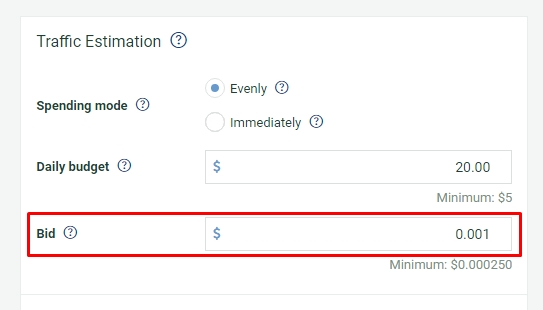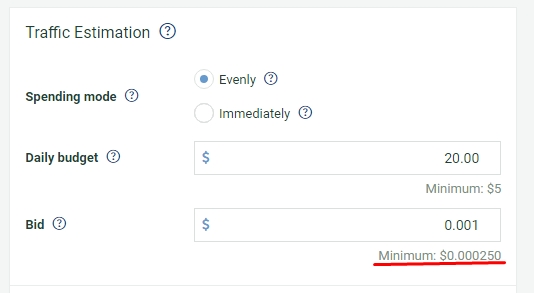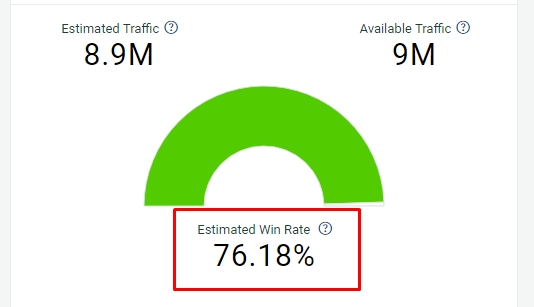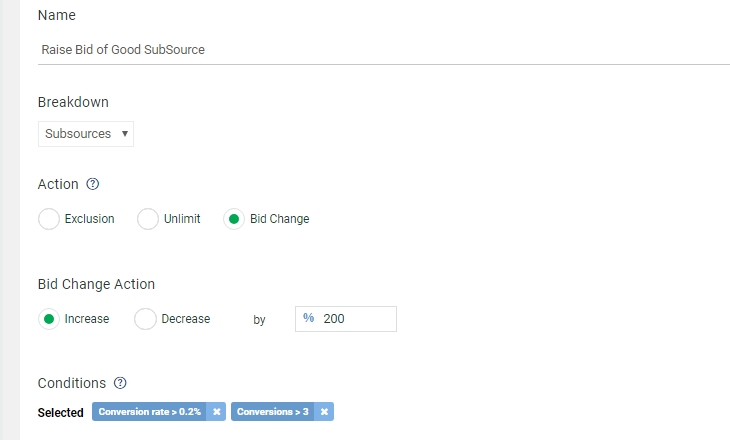Choose Cost Per Click (CPC) bids wisely in your campaigns to get more traffic, improve the quality of visitors you receive, and skyrocket your ROI.
As an advertiser or media buyer, most goals when purchasing traffic involve an attempt to get the best quality traffic possible. While the daily budget combined with the bid will determine how much traffic you can buy each day, the bid by itself is additionally a very powerful optimization tool that requires the least amount of effort. This doesn’t mean you should stop using our awesome Sources system to optimize ad campaigns, but it does mean that you may be underestimating the importance of the CPC bids you’re setting your campaigns up with.
What is a CPC bid?
A cost per click (CPC) bid is how much you’re willing and able to spend per visitor delivered to your campaign’s landing page, either via a pop window triggered by a click (when you’ve chosen pops as your delivery method) or a click on a display ad (f.ex. push notification, banner or native ad).
Setting your campaign’s CPC bid
When you’re creating a campaign inside PlugRush, at the top right of the campaign creator there is a section called ‘Traffic Estimation’ where you can input the CPC bid you would like to place. The image below illustrates the exact position in the campaign creator, where you can set your bid.

The minimum bid required
The minimum bid required per visitor is always determined by which delivery method and which GEO(s) you have chosen to target with your campaign. The PlugRush price list gives a general overview of all countries and delivery method combinations possible and how much the corresponding minimum, average and top CPC bids are.
The minimum bid is additionally listed in the campaign creator in the ‘Traffic Estimation’ section at the top right and adjusts dynamically based on the delivery method and countries you have selected to target.

Your bid determines your campaign’s win rate
The win rate % is a metric that indicates how much traffic your campaign was able to win out of the amount of traffic that was overall available to it. It’s expressed as a percentage and is going to depend a whole lot on the bid you place.
The win rate percentage of your campaign is VERY important
Once your campaign is running, you should closely monitor your campaign’s win rate using the campaign index‘s ‘Win Rate’ column.
If this metric is below 100% and you’re not receiving as much traffic as you would like to with your ad campaign, we definitely recommend increasing your campaign’s CPC bid to combat this.
A higher CPC bid will allow you to more effectively compete against other advertisers and media buyers attempting to get first dibs on the visitors you’re looking to monetize.
You can learn more about this meaningful metric in our quick guide about win rate.
PlugRush’s campaign creator will estimate your campaign’s win rate
In the campaign creator, you’ll also notice that the ‘Traffic Estimation’ section includes an estimation tool.
This feature was designed by our developers to give you a rough idea of the traffic you can win with your campaign, provided your daily budget is sufficient.
Additionally, the campaign creator will also estimate your campaign’s win rate %. This projection is provided where it says ‘Estimated Win Rate’ (screenshot below).

It’s very important to note that this is an estimate and you should still very much monitor your campaign’s actual win rate when it’s running. This will enable you to choose a CPC bid for it that is based on what actually happens as the campaign runs (versus what is predicted by the estimation tool). Reality always trumps a prediction.
Please feel free to utilize the campaign creator’s estimation feature in order to select an initial bid, but make sure to adjust the bid according to your campaign’s performance with regards to its win rate.
How to change your campaign’s bid
At some point, you will undoubtedly find yourself in a position that requires you to change your bid. This can be done quickly from the campaign overview. Just click on the CPC bid you’d like to edit.
When to increase your CPC bid
A complex set of variables will determine if you’ve placed a good bid on your campaign. As outlined in detail above, the win rate metric will tell you when it’s time to make a bid increase on your campaign in order to help improve its performance. Below are a few scenarios where it makes sense to increase your bid in order to improve the situation.
- Your campaign has run for a bit and its win rate is worse than the ideal 100% and you’re unhappy with the current traffic volume. In this case, it makes sense to increase your bid gradually in order to reach the best win rate % possible. A limiting factor here may be your campaign’s ROI, which you can work to improve using PlugRush’s Sources feature.
- Your campaign held a win rate that you were content with, but recently it has started to get worse. This means there is an increase in competition for the traffic you’re trying to purchase. In order to remain competitive with your campaign’s bid, you must raise it.
- Your campaign is not performing as well as you’d like. It has an win rate worse than 100% and you require visitor engagement (i.e. conversions) to have a successful run with your ad campaign. In this scenario, it makes a ton of sense to increase your bid because it can help improve performance by itself and will amplify other optimization methods you’re utilizing.
Automated Rules can automatically modify your bid based on campaign performance
With our automatic optimization tool, you can reduce your time spent on optimizing campaigns by up to 90%. Our PlugRush Automated Rules can even adjust your campaign bids for you, based on how your campaign is performing. Read this to learn how.

Thank you for reading!
Now you know all about CPC bids, how to set them and when to increase them. If you have questions about other parts of our system, you should check out our other guides, read the informative PlugRush blog, or hit up our support team.



